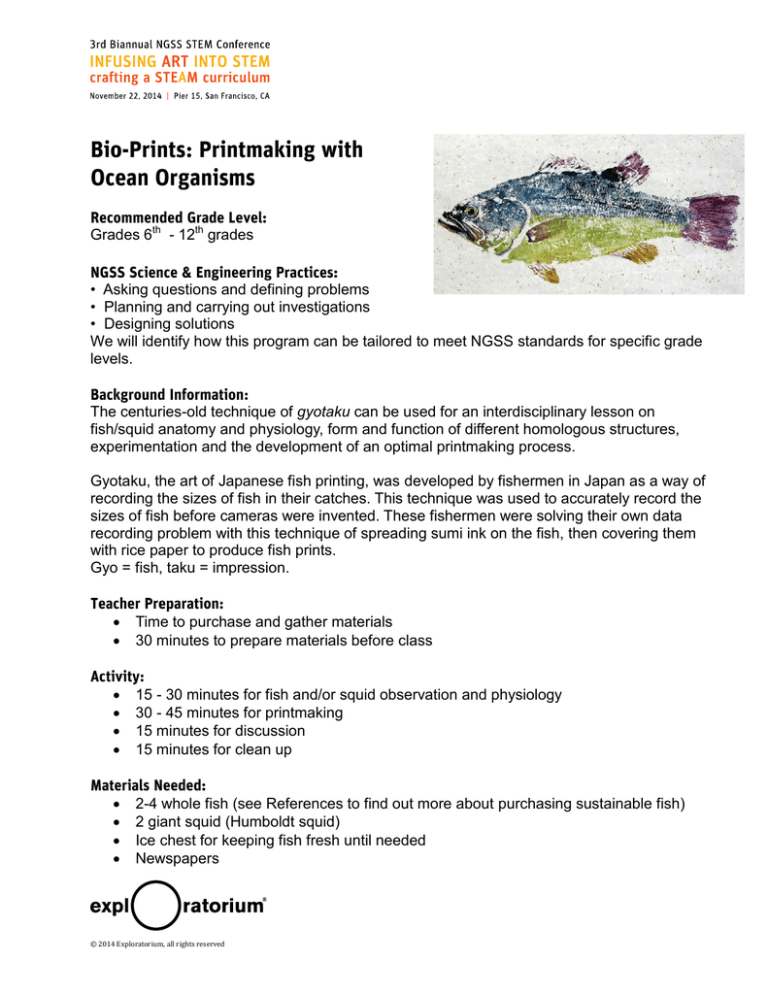
Grades 6th - 12th grades
• Asking questions and defining problems
• Planning and carrying out investigations
• Designing solutions
We will identify how this program can be tailored to meet NGSS standards for specific grade
levels.
The centuries-old technique of gyotaku can be used for an interdisciplinary lesson on
fish/squid anatomy and physiology, form and function of different homologous structures,
experimentation and the development of an optimal printmaking process.
Gyotaku, the art of Japanese fish printing, was developed by fishermen in Japan as a way of
recording the sizes of fish in their catches. This technique was used to accurately record the
sizes of fish before cameras were invented. These fishermen were solving their own data
recording problem with this technique of spreading sumi ink on the fish, then covering them
with rice paper to produce fish prints.
Gyo = fish, taku = impression.
Time to purchase and gather materials
30 minutes to prepare materials before class
15 - 30 minutes for fish and/or squid observation and physiology
30 - 45 minutes for printmaking
15 minutes for discussion
15 minutes for clean up
2-4 whole fish (see References to find out more about purchasing sustainable fish)
2 giant squid (Humboldt squid)
Ice chest for keeping fish fresh until needed
Newspapers
© 2014 Exploratorium, all rights reserved
Masking tape (optional)
Large trays (e.g. cafeteria trays) for materials
Magnifiers
Paper towels
Printing ink
Paint
Paint brushes (brushes, foam brushes)
Rollers (for paints and inks)
Printing paper (rice paper, newsprint, etc.)
Plastic bags
Sand
Modeling clay
Pins
Scissors
Dissection tray
2 heavy duty garbage bags for clean up
Access to sink
1. Cover tables with several layers of newspaper. Tape newspaper in place (optional).
2. Arrange materials (paints, inks, brushes, paper towels, etc.) on nearby trays.
3. Wash mucus off of the fish and pat dry with paper towels.
Fish/Squid External Anatomy: An Exploration of Body Parts and Function
Discuss the habitat where these animals survive. Have students identify external structures
and hypothesize functions using the vocabulary below:
Squid external anatomy
Two tentacles and eight arms – limbs for foraging and mating
Suckers – serrated structures for grasping prey
Mantle – main part of the body that contains major organs, torpedo-shaped to give
ultimate hydrodynamic shape
Syphon – tubular structure at the base of the mantle involved in propulsion and
excretion
Fins – steering, changing direction
Chromatophores – organelles that contain pigment, used for communication and
camouflage
Beak – chitinous structure for tearing and ingesting prey
© 2014 Exploratorium, all rights reserved
Eyes – vision underwater
Salmon external anatomy
Scales – “armored plating” for protection
Lateral line – a system of tactile sense organs used to detect water movement and
vibration
Fins – body protrusions webbed with skin that are supported by muscles, not the
skeletal system
o Pectoral – steering and changing direction
o Dorsal – stability and orientation
o Caudal – forward motion, propulsion
o Anal – stability
o Pelvic – up and down movement, turning and stopping
o Adipose – improves maneuverability in turbulent waters
Mouth and sharp teeth – foraging krill and small fish
Nostrils – smell, salmon are able to smell their way to rivers
Eyes – underwater vision
Operculum – body flap to protect the gills
Gills – extract oxygen from water, “feathered” to provide maximum surface area for
oxygen absorption
Gill rakers – strain plankton from water
Use magnifiers and/or microscopes to explore:
Fish scales, extracted gills and lateral line
Squid chromatophores and sucker discs
1. Make sure the fish/squid is completely dry.
2. Lay it flat on the newspaper.
3. Use sand-filled plastic bags, modeling clay and paper to stabilize the fish/squid in a
flat position.
4. Use pins to fan the fins/tail of the fish or the fins/arms/tentacles of the squid if desired.
5. Apply ink and/or paint with the implements provided. Experiment to find out what
works best. Focus on developing a process that produces the desired results.
6. Ask questions: Does applying paint from tail to head against the scales give better
detail? Experiment with different materials and techniques to find answers to
questions.
7. Avoid painting the eye for the print (it can be painted in by hand later).
8. Lay the print paper over the fish and carefully smooth the paper over the entire fish.
9. Carefully lift the print from the fish and lay flat or hang to dry.
10. Rinse ink and paint off fish for the next print.
© 2014 Exploratorium, all rights reserved
Review the external structures of the fish/squid and their functions. Discuss how each
structure is specially adapted to allow the animal to survive and thrive in the
marine/freshwater habitat. Have students identify human-induced threats facing both squid
and fish (overfishing, habitat destruction, pollution, etc.) and what people can to remediate
these impacts.
California Academy of Sciences Fish Print Activity:
http://www.calacademy.org/teachers/resources/lessons/fish-prints/
TED ED You Tube video on history of Gyotaku
http://ed.ted.com/lessons/gyotaku-the-ancient-japanese-art-of-printing-fish-k-erica-dodge
Nina Christiane Stokes article on Gyotaku for Alabama Cooperative Extension System:
http://www.aces.edu/dept/fisheries/education/documents/Fishprintactivitiy.pdf
For more information about sustainable seafood:
http://www.seafoodwatch.org
© 2014 Exploratorium, all rights reserved



